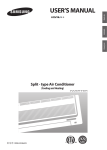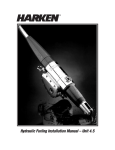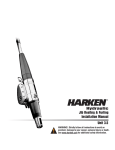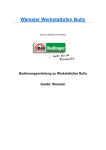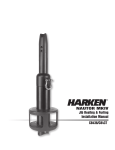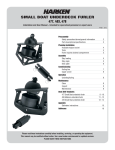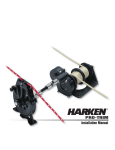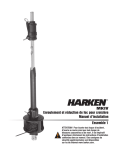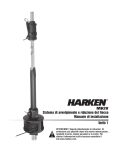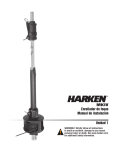Download Carbon Jib Reefing & Furling Installation Manual Unit 2/2.5
Transcript
Carbon Jib Reefing & Furling Installation Manual Unit 2/2.5 TABLE OF CONTENTS Parts 3 Pictures and list of all parts Specifications 4 Rod sizes Clevis pin sizes Luff tape sizes Rigging, attachment to lower unit Retrofits, fitting rod Tools required Supplies for gluing foils Alignment splints Headstay length Preparation for Assembly 5-6 Foil cut length Top foil cut length If you have a short top foil Cutting top foil Assembly 7-11 Sliding foils onto rod Attaching feeder Joining foils using connectors Preparing foil for gluing Gluing foils using Hysol® adhesive Gluing feeder Aligning joined foils Sliding halyard swivel onto foils Capping foils with trim cap Removing splint Installing Navtec® eye Installing carbon furling unit Assembling turnbuckle Foil height Commissioning 12-16 Tying soft attachment lines Halyard wraps Prevent halyard wraps Pendants Halyard restrainer Halyard tension Warranty Warranty of Harken Carbon parts is one year from the time of purchase. 2 2/2.5 Carbon Furler December 2001 PARTS 1 2 Prefeeder Toggle Cross pin* Smalley Ring Bottom (Feeder) Connector Clevis pin Cotter pin Top Bushing Torque Tube Connector *Cross pin includes (2) H2912A bushings. (36) Connector bushings Regular Connectors 3 4 Halyard Swivel Trim Cap 5 Feeder 1 Prefeeder . . . . . . . . . . . . . . . . . . . . . . . . . . . . . . . . . . . . Toggle . . . . . . . . . . . . . . . . . . . . . . 5/8" (15.9mm) . . . . Toggle . . . . . . . . . . . . . . . . . . . . . . 3/4" (19mm) . . . . . . Cross Pin . . . . . . . . . . . . . . . . . . . 5/8" (15.9mm) . . . . Cross Pin . . . . . . . . . . . . . . . . . . . 3/4" (19mm) . . . . . . Cotter Pin . . . . . . . . . . . . . . . . . . . . . . . . . . . . . . . . . . . Smalley Rings . . . . . . . . . . . . . . . 5/8" (15.9mm) . . . . Smalley Rings . . . . . . . . . . . . . . . 3/4" (19mm) . . . . . . Clevis Pin . . . . . . . . . . . . . . . . . . . 5/8" (15.9mm) . . . . Clevis Pin . . . . . . . . . . . . . . . . . . . 3/4" (19mm) . . . . . . 947 H-29364C H-27385C H-29388A H-27407A HFG344 HCP1352 HCP1062 H-29385A H-29386A Bottom (Feeder) Connector . . . . . . . . . . . . . . . . . . . . . Regular Connectors . . . . . . . . . . . . . . . . . . . . . . . . . . . Top Bushing . . . . . . . . . . . . . . . . . . . . . . . . . . . . . . . . . Torque Tube Bushing . . . . . . . . . . . . . . . . . . . . . . . . . . H-27448BF 1096F H-27508BF H-27902BF 2 3 Lower Unit Assembly Connector Bushings (36) . . . . . . . . . . . . . . . . . . . . . . . H-27495A Trim Cap . . . . . . . . . . . . . . . . . . . . . . . . . . . . . . . . . . . . H-27904B Feeder . . . . . . . . . . . . . . . . . . . . . . . . . . . . . . . . . . . . . . H-29238B 4 Halyard Swivel . . . . . . . . . . . . . . . . . . . . . . . . . . . . . . . H-29662C 5 Lower Unit Assembly . . . . . . . . . . . . . . . . . . . . . . . . . . H-27374EF Lacing Lines (3) 1/4" (6mm) Spectra® . . . . . . . . . . . . . HFG6907 May 2002 2/2.5 Carbon Furler 3 SPECIFICATIONS ■ Rod Sizes -12, -17, -22 (7.14mm, 8.38mm, 9.53mm) ■ Tools Required Sharp Hacksaw, Sandpaper, Small Triangular File, Heat Gun, Razor Knives, Sandpaper. ■ Clevis Pin Sizes 5/8", 3/4" (15.9 mm, 19.1 mm) ■ Luff Tape Size #6, 6/32", (5mm) ■ Rigging, Attachment to Lower Unit If no turnbuckle is required, attach the rod marine eye directly to the integral toggle on the 2.5. If a turnbuckle is required, it must terminate in a marine eye that will fit directly to the integral toggle. Use a Navtec C560 turnbuckle or similar for rod with either a 5/8" (15.9mm) pin or 3/4" (19mm) pin diameter. ■ Retrofits, Fitting Rod If you plan to reuse the existing rod and turnbuckle: Lower End—If you are using a standard Navtec turnbuckle with integral toggle, the lower body must be replaced with a standard Navtec marine eye body. Check to make sure that this eye will mate with the Harken integral toggle. Two cross pin sizes are available. They are the same size as the clevis pin. See above. Upper End—You must take apart the marine eye so that you are left with a threaded nosepiece. Check to see if this is possible. If necessary, contact Navtec or Riggarna for correct procedure. You will slip carbon foils over this threaded nosepiece. If you cannot remove this fitting you will need to cut the rod. 4 ■ Supplies Required for Gluing Foils Rigging tape, blue masking tape, 9430 Hysol Epoxy (supplied), Scissors, mixing cup, mixing stick, glue brushes, acetone, paper towels cut into quarters, plastic to cover splint area, clear packaging tape, wood alignment stick and placemat-sized table covering. Alignment Splints - Use 90° angle extrusion to make splints. Sides to be about 3/4" (19mm). Cut extrusion into 8" (203mm) lengths and remove burrs from cutting. ■ Headstay Length Note: When cutting rod to length or making up new rod, make sure that you can take apart the rod terminal (usually the top eye) so that you are left with a threaded nosepiece. Make up the rod headstay or adjust the turnbuckle so the Harken toggle fits below the rod terminal eye. The pin-to-pin distance of the Harken toggle is 31/4" (83mm). Note: The 2.5 Carbon furler has an integral toggle. No additional toggle is required below the furler. 2/2.5 Carbon Furler May 2002 PREPARATION FOR ASSEMBLY Foil Cut Length • Top Foil Cut Length • Short Top Foil? • Cutting Top Foil ■ FOIL CUT LENGTH The Carbon 2.5 furler has an integral toggle. No additional toggle is required below the unit. To check the foil length, lay foils alongside the stay before cutting top foil. Make sure that turnbuckle is set to desired length. ■ TOP FOIL CUT LENGTH Instructions for worksheet below: 1 Fill in total pin-to-pin headstay length. 2 Fill in A length. 3 Adjust B length if necessary. Note: There must be enough space between top of carbon foils and bottom of rod terminal to allow for turnbuckle adjustment. As turnbuckle is adjusted, terminal is pulled down towards top of rod. If no turnbuckle is used, there only needs to be minimal space—1/2" (12mm)–between the carbon foil and rod terminal. We have put 4" (100mm) as a starting point. This may need to be adjusted based upon how turnbuckle was set when headstay was measured. If there is less than 4" (100mm) “take-up”, less space can be left and vice versa. The space between foil trim cap and bottom of turnbuckle must be more than “take-up” on turnbuckle. 4 Add A, B, E and subtract from total pin-to-pin headstay length. SUM = _________ 5 Choose the number from foil multiplier below closest to, but not greater than, sum from step 4. Fill in D length. 6 X 72" = 432 6 X 1828.8mm = 10972.8 7 x 72" = 504 7 x 1828.8mm = 12801.6 8 x 72" = 576 8 x 1828.8mm = 14630.4 9 x 72" = 648 9 x 1828.8mm = 16459.2 10 x 72" = 720 10 x 1828.8mm = 18288.0 11 x 72" = 792 11 x 1828.8mm = 20116.8 A C D 5 Add A, B, D, E. Subtract from pin-to-pin length for C (top foil length). WORKSHEET: DETERMINE TOP FOIL LENGTH Dimensions A Center of PIN to bottom of terminal B Bottom of terminal to top of foil Inches mm ______________ 4 102 C Top foil Foils below 8" (203mm) see next page ______________ D _____ x 72" (1828.8mm) foils ______________ E Top of feeder to center of clevis pin Total pin-to-pin headstay length 523/4 E 1340 ______________ IF YOU HAVE SHORT TOP FOIL If top foil is less than 8" (203mm) do not use a recessed top connector. The top foil must be at least 4" (101mm). If it is less, shorten the upper 72" (1.83m) foil to make the upper foil 4" (101mm). CUTTING TOP FOIL Once you have checked the top foil length by laying foils alongside the rod, use a sharp hacksaw to cut top foil. Tape foil and cut along tape. Sand bottom end of the foil so it is square and to remove any carbon burrs. Lightly sand inside of foil where it will be bonded with 220 grit to remove any grease or mold release agent. June 2002 2/2.5 Carbon Furler 5 PREPARATION FOR ASSEMBLY Tape outside ends of all foils using blue masking tape. To make sure tape edge lines up with end of foil, extend the tape over foil end. Use a sharp razor knife to trim tape even with foil. Coat rod with mold release agent or wax to keep epoxy from adhering. Heat rod terminal and remove threaded screw and threaded nosepiece. If rod terminal has been upset (peened), follow Navtec or Riggarna procedures for removing peening. Tape threads of nosepiece and tape nosepiece so it will not slip down foil when pushing it back out. 6 2/2.5 Carbon Furler December 2001 ASSEMBLY Assuming that installation is done from the top, slide bottom foil onto rod so end with holes is at bottom end of foil. Slide feeder over so, so rounded sail groove corners will be at the bottom end of foil. Slide full-length 72" (1.83m) foils onto the rod. Assemble connectors onto rod in preparation for glueing. Place one bushing half in socket on either side of connector, grooved side up. Bring connector up on rod and place other bushing half on rod and rotate bushing so seam is at top and bushing assembly stays in place. Place foil on bench with grooves facing up and supported on wood blocks. June 2002 2/2.5 Carbon Furler 7 assembly Cool Weather Temperature should be higher than 60°F (15°C). If you glue at a lower temperature: 50°F (10°C) minimum gently warm joints with a hair dryer to no more than: 100°F (38°C), a temperature at which you can still hold the foil comfortably in your hand. If glued in temperature less than 60°F (15°C, allow glued foils to cure undisturbed for 48-hours before moving. Adhesive Alert You must follow four-step mixing instructions shown below exactly or the foil connector bond will fail. Warm Weather Surfaces must be dry. Adhesive Working Times: 75°F (24°C) - 1 hour 85°F (29°C) - 45 minutes Allow glued foils to cure undisturbed for 24-hours Remove plastic clip from Hysol® adhesive pack. 1) Mix for five minutes in bag. 2) Pour entire contents into cup. 3) Squeegee remaining epoxy into cup. 4) Continue to thoroughly stir epoxy in cup. Use glue brush to coat the inside of the foil for one or two inches. Coat 1/2 of the outside of the connector with epoxy and slowly insert the connector into the foil. Work the connector in and out as you insert it to adhere the epoxy without dry spots on the inside of the foil. As excess epoxy comes off the connector, clean it up using the acid brush. Use excess to coat feeder area of connector. Clean up the end of the foil using paper towel wetted with acetone taking care that no epoxy is in the sail grooves. 8 2/2.5 Carbon Furler May 2002 assembly Lightly coat feeder area of connector and slip feeder into place. Use glue brush to coat inside of foil for one or two inches. Coat half the outside of connector with epoxy and slowly insert connector into foil. Work connector in and out as you insert to adhere epoxy without dry spots on inside of foil. As excess epoxy comes off connector, clean up using acid brush. Clean up end of foil using paper towel wetted with acetone, taking care that no epoxy is in sail grooves. Coat the remaining half of connector with epoxy and insert into foil as described above, cleaning up excess epoxy. Take special care to clean epoxy from sail grooves. May 2002 2/2.5 Carbon Furler 9 assembly Lay plastic against foil and place splint against foil. Tightly wrap clear packaging tape around splint near both ends. Insert wood alignment stick between foil and feeder and inspect to make sure that foil/feeder are aligned. Coat bottom foil reinforcement (torque tube connector) with epoxy and insert into foil as directed above. Insert plastic bushings in top connector as directed above. Coat outside of connector with epoxy as directed above and insert into top foil. Clean up excess epoxy. Slide halyard swivel onto foils. Make sure swivel side is towards top of stay! Slide trim cap over threaded nosepiece. Heat cap in hot water to help it slide over nosepiece. Attach trim cap using Superglue®. Make sure foils are straight and grooves are facing up. Inspect lower unit to make sure that feeder and bottom foil are aligned correctly. Allow to cure undisturbed overnight. After curing overnight, remove splint. Use a small triangular file to clean excess epoxy while tape remains in place. Remove tape and use a razor knife to carefully remove any excess epoxy. Make sure halyard swivel passes all points. Install top rod eye using red Loctite® on locking screw or with upset as per manufacturer's instructions. Remove eight socket-head cap-screws located on underside of lower unit and remove lower cap. Remove three set screws located at top of torque tube. 10 2/2.5 Carbon Furler December 2001 assembly Slide lower unit onto bottom foil. Assemble turnbuckle. Attach turnbuckle eye to toggle using cross pin with tapered ends. Secure Cross Pin using Circlip (Smalley Rings) supplied. Note: Make sure the end of the toggle with the long slot is towards the bottom. Long Slot Bring the lower unit down so that Cross Pin seats in the housing. Install cap using Blue Threadlocker® on the eight screws. ■ FOIL HEIGHT Check the clearance between the top of the foil and top terminal. TIP: Check clearance when the unit is on the ground, before raising the headstay into position. WARNING: It is critical to have clearance between the top foil and the top rigging fitting when the stay adjuster is in the fully closed position. If the fittings touch, the unit will jam or in the case of a Sta-Lok fitting, the terminal may become unscrewed. This could cause catastrophic failure to the spar and a life threatening situation It is the responsibility of the rigger to check clearance. December 2001 2/2.5 Carbon Furler 11 COMMISSIONING Tying Soft Attachment Lines You must lace line around the furler/halyard swivel three times when attaching the sail or halyard. Harken recommends us of a Hunter's Bend. This knot can be highly tensioned without slipping and like a bowline can be untied afterwards. There are other bends and knots that will also work. Lace line three times around the torque tube/halyard swivel to capture sail or halyard. After lacing line, tie ends on side opposite sail. 1 Form a loop in line that comes from left tunnel. Below this, form a second loop with line from the right tunnel. 2 Twist loop clockwise and arrange ends of line so they are below standing loops as shown. 12 2/2.5 Carbon Furler December 2001 COMMISSIONING Tying Soft Attachment Lines 3 Take end that is now running down to right. Tuck it down under crossing lines and up through loop, towards you. 4 Pass other end up and over crossing lines and then down into loop, away from you. 5 At this point knot will not look anything like the finished bend. Set knot by gently pulling on bitter ends and then standing parts until it looks like Drawing 6. December 2001 2/2.5 Carbon Furler 13 COMMISSIONING Tying Soft Attachment Lines 6 7 Finished bend drawn up and set. If your bend does not look like this untie and repeat the process. 9 If furler is installed under deck, lace tack pendant as pictured. Rigging a pendant directly from carbon tunnels will damage unit. 8 It is important to keep tack/luff as close to torque tube and as low as possible. A tack line that is too long will angle up too far and damage the carbon tunnels. When sail is bent on, check to make sure tack line is not pulling up against the carbon tunnels. 14 2/2.5 Carbon Furler December 2001 COMMISSIONING Halyard Wraps • Prevent Halyard Wraps ■ HALYARD WRAPS The most serious problem with furling systems occurs when the jib halyard wraps around the headstay foil. Halyard wraps will prevent furling or unfurling and may cause serious damage to the unit and the halyard. In severe cases, halyard wraps may cause loss of the headstay. To prevent wraps, the halyard must exert a slight pull to the rear. This allows the foils to turn while the halyard remains stationary. ■ PREVENT HALYARD WRAPS WARNING: The sail must be fitted to foils before operation. 1 Halyard swivel should be within top 4" (100mm) of foil. 2 Halyard must pull slightly to rear (8 - 10°). 3 Halyard must be snug, but not too tight. If a halyard wraps, do not force unit to turn. Attempt to open sail by alternately furling and unfurling sail slightly. If the sail can be unfurled, lower sail by releasing jib halyard. Severe halyard wraps can only be cleared by going aloft and freeing halyard. If the sail will not furl or unfurl, it may be possible to remove jib sheets and manually wrap/unwrap the sail around/from the headstay. Important: Testing at the dock does not indicate halyard angle is correct. In wave action, halyard may wrap if lead angle is not correct. The diverging 8-10° angle mentioned above is critical. December 2001 2/2.5 Carbon Furler 8 - 10° 15 COMMISSIONING Pendants • Halyard Restrainer ■ PENDANTS If your sail is not long enough to position halyard swivel properly, you must add a pendant to sail. Pendants should be plastic-coated wire permanently attached to the head of sail so height will be correct. Adjustable length pendants are not acceptable as they might not be adjusted correctly during a sail change. ■ INSTALL A PENDANT 1 Raise sail, but do not attach tack shackle. 2 Position halyard swivel correctly near top of headstay and secure halyard. 3 Secure a piece of rope to sail tack. Lead line through tack shackle on furling drum and tension sail. 4 Measure distance from tack shackle to sail tack and have a pendant of this length permanently attached to head of sail. 5 Repeat this procedure for every jib. TIP: Pendants are used at head of sail. Short pendants may be added at tack to improve visibility under genoa, but remember that visibility is already improved by shackling to tack swivel. Tack pendants increase heeling moment by raising sailplan. You may install pendants at both head and tack of sail. ■ HALYARD RESTRAINER To prevent wraps, the jib halyard must pull slightly to the rear. On some boats the halyard sheaves are located too close to the headstay and a halyard restrainer must be used. Use halyard restrainers only when required by the masthead geometry. Restrainers tend to limit sail luff length and may cause problems if not properly installed. Mount the restrainer as high as possible on the face of the mast. Position the restrainer so the foils will not hit it when under load. The restrainer should deflect the halyard 8 - 10°. If the angle is more than 10°, you may experience difficulty in tensioning the sail luff, friction in furling and possible damage to the foils. To decrease deflection angles, shorten the luff of the sail. 8 - 10° TIP: Boats used in charter service should consider using a halyard restrainer, regardless of masthead geometry. 16 2/2.5 Carbon Furler December 2001 COMMISSIONING Halyard Tension ■ HALYARD TENSION The jib halyard should be firm, but not too tight. TIP: The luff foil system supports the sail along its entire length so halyard tension is required only to shape sails, not to support them. Use only enough halyard tension to remove some wrinkles along the luff. Do not tension the halyard enough to cause vertical wrinkles in the luff. Use halyard tension to adjust draft position of the sail to suit sailing conditions. Your halyard should be firm but not tight. If in doubt, release halyard tension. To protect the sail, ease the halyard when the boat is not in use. December 2001 2/2.5 Carbon Furler 17 Corporate Headquarters 1251 East Wisconsin Avenue, Pewaukee, Wisconsin 53072 USA Telephone: (262) 691-3320 • Fax: (262) 691-3008 • Cable: Harken Pewaukee Web: www.harken.com • Online Catalog: www.harkenstore.com Email: [email protected] Harken France ZA. Port des Minimes, BP 3064, 17032 - La Rochelle Cedex 1, France Telephone: (33) 05.46.44.51.20 • Fax: (33) 05.46.44.25.70 Web: www.harken.fr Email: [email protected] Harken Italy S.P.A. Via Marco Biagi, 14, 22070 Limido Comasco, (CO), Italy Telephone: (39) 031.3523511 • Fax: (39) 031.3520031 Web: www.harken.it Email: [email protected] Harken UK Ltd. Bearing House, Ampress Lane Lymington, Hampshire S041 8LW, England Telephone: (44) 01590-689122 • Fax: (44) 01590-610274 Web: www.harken.co.uk Email: [email protected] Harken Poland ul. Lisa Kuli 4 Lok.1, 01-512 Warszawa, Polska Telephone: +48 607 979 747 Web: www.harken.com Email: [email protected] Harken Sweden Mjölkekilsgatan 6, Box 64 S-440 30 Marstrand, Sweden Telephone: (46) 303-618 75 • Fax: (46) 303-618 76 Web: www.harken.se Email: [email protected] Harken Adriatik d.o.o. Obala 107 6320 Portoroz, Slovenia Telephone/Fax: 5-6774122 Web: www.harken.si Email: [email protected] Harken Australia, Pty, Ltd. 1B Green Street Brookvale, N.S.W. 2100, Australia Telephone: (61) 2-8978-8666 • Fax: (61) 2-8978-8667 Web: www.harken.com.au Email: info.harken.com.au Harken New Zealand, Ltd. 30-36 Fanshawe Street Auckland 1001, New Zealand Telephone: (64) 9-303-3744 • Fax: (64) 9-307-7987 Web: www.harken.co.nz Email: [email protected] Please visit: http://www.harken.com/dealers/dealers.php for an up-to-date list of Harken dealers and distributors 4362/9-08


















